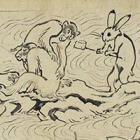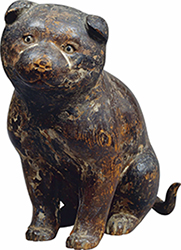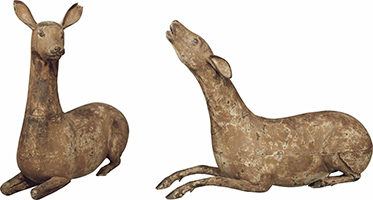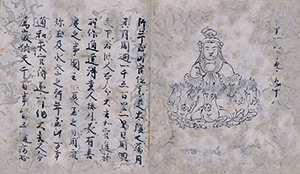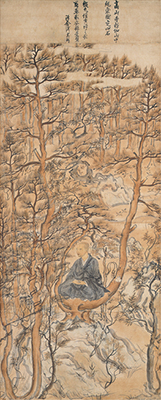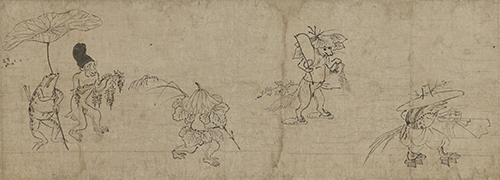Highlights of the Exhibition
*Objects will be rotated during the course of the exhibition period. Objects for which “on exhibit” dates are not specified will be on display for the full term of the exhibition.
Chapter 1: The Treasures of Kosan-ji Temple
Kosan-ji Temple was revived by the priest Myo'e at the start of the Kamakura period and subsequently developed as a training center for monks. It also housed many beautiful artworks that have survived to the present day.
These include many thematically-consistent hakubyo, or ink line paintings based on the teachings of esoteric Buddhism. These served as models for Buddhist paintings and also contributed to the rise of new schools of Buddhist thought and teaching. Another feature of Kosan-ji’s collection is a large number of charming animal statues. These are thought to have been made under the influence of Myo'e and were later used in rituals too.
Kosan-ji served as a wellspring of new art and new ideas. It also collected and stored cultural assets from various genres and ensured they were handed down to later generations. As such, it has played an important role as a bastion of Buddhist culture.
Puppy
Kamakura period, 13th century
Important Cultural Property
Kosan-ji, Kyoto
Sacred Deer
Kamakura period, 13th century
Important Cultural Property
Kosan-ji, Kyoto
Bonten Kara-Kuyozu (Esoteric Buddhist Text of Astrology)
By Gensho
Heian period, dated 1189 (Bunji 5)
Important Cultural Property
Kosan-ji, Kyoto
(on exhibit : April 28 - May 17, 2015)
Page top
Chapter 2: Myo'e – The Priest who Revived Kosan-ji Temple
The life of the priest Myo'e, who revived Kosan-ji Temple, was peppered with many colorful episodes. Historical records attest to his strictness as an inquirer into the truth. He developed his own philosophy that combined Kegon and esoteric Buddhism, for example. He also cut off his right ear to prove his dedication to truthseeking, while his yearning for Sakyamuni led him to plan a sea journey to India. At the same time, his humanity shone through in his manifold talents. He recorded his dreams throughout his life, for instance, and also composed a number of classical Japanese waka poems.
This rich life was reflected in the numerous artworks that sprung up around Myo'e and Kosan-ji. With their powerful sense of individuality, these items have carved their own unique niche among the voluminous world of Japanese Buddhist art works.
Portrait of Priest Myo'e (meditating in a tree)
Kamakura period, 13th century
National Treasure
Kosan-ji, Kyoto
(on exhibit : April 28 - May 17, 2015)
Illustrated History of the Founders of the Kegon Sect, Chapter on Priest Gisho (Uisang)
Kamakura period, 13th century
National Treasure
Kosan-ji, Kyoto
(on exhibit : April 28 - May 17, 2015)
Illustrated History of the Founders of the Kegon Sect, Chapter on Priest Gangyo (Wonhyo)
National Treasure
Kosan-ji, Kyoto
(on exhibit : May 19 - June 7, 2015)
Page top
Chapter 3: The National Treasure Choju Giga
The National Treasure Choju Giga, or ‘Frolicking Animals’, is perhaps Japan’s most famous set of illustrated scrolls. Yet it is also a work shrouded in mystery. There is no text, so we don’t know why it was painted or what it is actually trying to depict.
However, although the Japanese title contains the word ‘giga,’ or caricature, it would be a huge mistake to assume the work is merely a playful drawing. If you look really closely, you can tell it is the work of very talented people. Over four scrolls, the artists have masterfully used ink lines to paint scenes based on a cool-headed observation of the world. At the very least, this artistry suggests the work was not just painted ‘for fun.’
This exhibition displays all four volumes of Choju Giga following the completion of a fouryear conservation project that began in 2009. It also brings together several fragments, some of which are preserved outside Japan. As such, it provides a rare opportunity to view Choju Giga in its entirety.
Frolicking Animals
Heian period, 12th century
National Treasure
Kosan-ji, Kyoto
Volume 1
This scene on exhibit : April 28 - May 17, 2015
This scene on exhibit : May 19 - June 7, 2015
Volume 2
This scene on exhibit : April 28 - May 17, 2015
This scene on exhibit : May 19 - June 7, 2015
Volume 3
This scene on exhibit : May 19 - June 7, 2015
Volume 4
This scene on exhibit : April 28 - May 17, 2015
Frolicking Animals, Fragment
Heian period, 12th century
Kosan-ji, Kyoto
Page top

